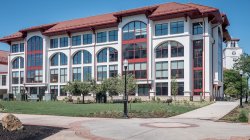Introducing the Center for Computing and Information Science
Mallory Hall transformed into a technologically advanced research and instructional facility
Posted in: University

When it was dedicated in 1963 to honor former Montclair State Mathematics Professor Virgil Mallory, Mallory Hall was state-of-the-art – a modern educational facility with up-to-date classrooms, labs and a lecture hall. More than half a century later, thanks to a complete renovation and expansion, the 34,400-square-foot Mallory Hall has been transformed into the 43,800-square-foot, cutting-edge Center for Computing and Information Science, scheduled to open in August.
Funded in part by $7 million in phase-two state bond funds received by the University, the new $22.2 million facility – like the recently renovated Partridge Hall, three-year-old Center for Environmental and Life Sciences, and Feliciano School of Business building – supports Montclair State’s mission as a Carnegie-designated research doctoral university and state-designated public research institution.
“The new Center will allow Montclair State, New Jersey’s second-largest university, to sustain and grow high-quality, high-demand science programs that are directly aligned with the state’s and our students’ needs,” says Dean of the College of Science and Mathematics Lora Billings. “Our programs focus on core and competitive areas of STEM education. To teach students these 21st century skills, you need a 21st-century facility.”
The renovation project has reimagined and repurposed existing classroom and laboratory spaces and added a fourth floor to accommodate the thousands of students who take courses and pursue degrees in computer science and information technology. “There are 19 classrooms and labs in the building, with a dynamic mix of rooms designed specifically to support research, teaching labs and instruction,” says Associate Vice President for Capital Planning and Project Management Michael Zanko.
Classrooms and labs in the Center for Computing and Information Science include specialized research labs and instructional spaces for areas such as cybersecurity, data science, image processing, parallel and distributed computing, human-computer interaction, and computational sensing.
The University’s strategic technology partner Sony Electronics has delivered a unique mix of classroom technologies, active learning solutions and state-of-the-art professional equipment such as laser projectors; 55- and 85-inch displays; robotic pan/tilt/zoom cameras in collaborative spaces; and wireless microphone systems to the high-tech center.
“We worked closely with the University to help achieve their primary goals,” says John Garmendi, Sony Electronics’ Higher Education Strategic Business Development Manager. “The technology in the building needed to be brought up to date to keep pace with the trends toward active learning. Also, the dean and faculty wanted to break down the academic silos between departments to provide a more comprehensive and engaging overall learning environment.”
The Center – which will also be home to the College of Science and Mathematics Student Success Center, Mathematics Education group, Health Careers, and Upward Bound programs – has been fitted with new heating, cooling, plumbing and electrical upgrades, remediated environmental systems, and more. Its new exterior façade reflects the campus’ iconic Mission Revival architectural style. It also features ceiling-to-floor windows with panoramic views of the New York City skyline to the east and the student quad to the west.
Department of Computer Science Chair, Constantine Coutras, is especially looking forward to the Center’s significantly expanded, state-of-the-art research spaces. “With two research labs on the third floor and five research labs on the new fourth floor, we’ll be able to offer new graduate degrees – including an MS in Cybersecurity, and an MS in Data Science– which are pending official approval,” Coutras explains.
Coutras also notes that the Center’s teaching spaces include a 145-seat amphitheater and five teaching computer labs, as well as a specialized hardware lab, and a smaller computer lab for independent student work. All classroom spaces are fitted with projectors and computers.
“Another standout feature is the reconstructed and expanded skywalk that connects the Center to neighboring Schmitt Hall, which provides a beautiful high-tech common area for our students, faculty, and staff,” Billings adds. “These common areas in the Center are essential for creativity and collaboration. They encourage increased communication within and across different disciplines, inspiring new research directions.”
